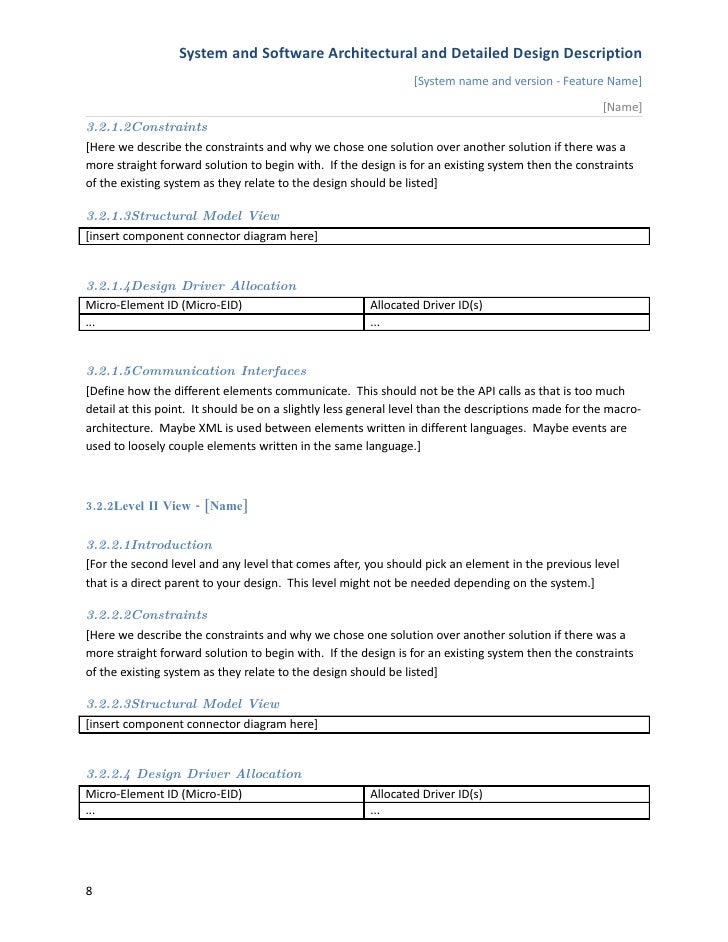System Architecture Description Document Template
- The SDD documents the high-level system design and the low-level detailed design specifications. The SDD describes design goals and considerations, provides a high-level overview of the system architecture, and describes the data design associated with the system, as well as the human-machine interface and.
- System Architecture Description of XXX Doc # Version: 2013 Page 1 / 1 This Template is the property of Cyrille Michaud. System Architecture Document Template Introduction Document overview Abbreviations and Glossary Abbreviations Glossary References Project References Standard and regulatory References Conventions Architecture Architecture.
The Technical Architecture Document (TAD) continues on beyond the project closure as a 'living' document. For this reason it is created as an independent MSWord document, a working copy of this is attached to this page during the life of the project. To obtain a TAD template, click on the link below which will open a read-only view.
| IEEE software life cycle |
|---|
|
A software design description (a.k.a. software design document or SDD; just design document; also Software Design Specification) is a written description of a software product, that a software designer writes in order to give a software development team overall guidance to the architecture of the software project. An SDD usually accompanies an architecture diagram with pointers to detailed feature specifications of smaller pieces of the design. Practically, the description is required to coordinate a large team under a single vision, needs to be a stable reference, and outline all parts of the software and how they will work.
Composition[edit]
The SDD usually contains the following information:
- The data design describes structures that reside within the software. Attributes and relationships between data objects dictate the choice of data structures.
- The architecture design uses information flowing characteristics, and maps them into the program structure. The transformation mapping method is applied to exhibit distinct boundaries between incoming and outgoing data. The data flow diagrams allocate control input, processing and output along three separate modules.
- The interface design describes internal and external program interfaces, as well as the design of the human interface. Internal and external interface designs are based on the information obtained from the analysis model.
- The procedural design describes structured programming concepts using graphical, tabular and textual notations.
These design mediums enable the designer to represent procedural detail, that facilitates translation to code. This blueprint for implementation forms the basis for all subsequent software engineering work.
IEEE 1016[edit]
IEEE 1016-2009, titled IEEE Standard for Information Technology—Systems Design—Software Design Descriptions,[1] is an IEEE standard that specifies 'the required information content and organization' for an SDD.[2] IEEE 1016 does not specify the medium of an SDD; it is 'applicable to automated databases and design description languages but can be used for paper documents and other means of descriptions.'[3]
System Architecture Design Document
The 2009 edition was a major revision to IEEE 1016-1998, elevating it from recommended practice to full standard. This revision was modeled after IEEE Std 1471-2000, Recommended Practice for Architectural Description of Software-intensive Systems, extending the concepts of view, viewpoint, stakeholder, and concern from architecture description to support documentation of high-level and detailed design and construction of software. [IEEE 1016, Introduction]
Following the IEEE 1016 conceptual model, an SDD is organized into one or more design views. Each design view follows the conventions of its design viewpoint. IEEE 1016 defines the following design viewpoints for use:[4]

- Context viewpoint
- Composition viewpoint
- Logical viewpoint
- Dependency viewpoint
- Information viewpoint
- Patterns use viewpoint
- Interface viewpoint
- Structure viewpoint
- Interaction viewpoint
- State dynamics viewpoint
- Algorithm viewpoint
- Resource viewpoint
In addition, users of the standard are not limited to these viewpoints but may define their own.[5]
See also[edit]
System Architecture Document Example
References[edit]
- ^'IEEE Standard for Information Technology — Systems Design — Software Design Descriptions'. IEEE. 2009-07-20. Retrieved 2014-07-06.
- ^IEEE 1016, Abstract.
- ^IEEE 1016, Abstract.
- ^IEEE 1016, Clause 5.
- ^IEEE 1016, sub-clause 4.5.